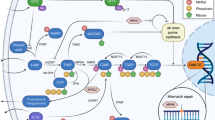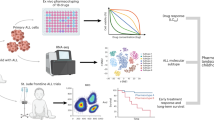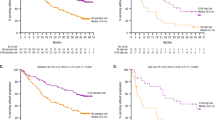Abstract
Methotrexate/6-mercaptopurine maintenance therapy improves acute lymphoblastic leukemia (ALL) outcome. Cytotoxicity is mediated by DNA incorporation of thioguanine nucleotides (DNA-TG). We investigated the association of DNA-TG to relapse risk in 1 910 children and young adults with non-high risk ALL. In a cohort-stratified Cox regression analysis adjusted for sex, age, and white cell count at diagnosis, the relapse-specific hazard ratio (HRa) per 100 fmol/μg increase in weighted mean DNA-TG (wmDNA-TG) was 0.87 (95% CI 0.78–0.97; p = 0.013) in the 839 patients who were minimal residual disease (MRD) positive at end of induction therapy (EOI), whereas this was not the case in EOI MRD-negative patients (p = 0.76). Validation analysis excluding the previously published Nordic NOPHO ALL2008 pediatric cohort yielded a HRa of 0.92 (95% CI 0.82–1.03; p = 0.15) per 100 fmol/μg increase in wmDNA-TG in EOI MRD-positive patients. If also excluding the United Kingdom cohort, in which samples were taken non-randomly in selected patients, the HRa for the EOI MRD-positive patients was 0.82 (95% CI 0.68–0.99; p = 0.044) per 100 fmol/μg increase in wmDNA-TG. The importance of DNA-TG as a biomarker for maintenance therapy intensity calls for novel strategies to increase DNA-TG, although its clinical value may vary by protocol backbone.
This is a preview of subscription content, access via your institution
Access options
Subscribe to this journal
Receive 12 print issues and online access
$259.00 per year
only $21.58 per issue
Buy this article
- Purchase on Springer Link
- Instant access to full article PDF
Prices may be subject to local taxes which are calculated during checkout


Similar content being viewed by others
References
Schmiegelow K, Nielsen SN, Frandsen TL, Nersting J. Mercaptopurine/Methotrexate maintenance therapy of childhood acute lymphoblastic leukemia: clinical facts and fiction. J Pediatr Hematol Oncol. 2014;36:503–17.
Nielsen SN, Grell K, Nersting J, Frandsen TL, Hjalgrim LL, Schmiegelow K. Measures of 6-mercaptopurine and methotrexate maintenance therapy intensity in childhood acute lymphoblastic leukemia. Cancer Chemother Pharm. 2016;78:983–94.
Swann PF, Waters TR, Moulton DC, Xu YZ, Zheng Q, Edwards M, et al. Role of postreplicative DNA mismatch repair in the cytotoxic action of thioguanine. Science. 1996;273:1109–11.
Gefen N, Brkic G, Galron D, Priel E, Ozer J, Benharroch D, et al. Acquired resistance to 6-thioguanine in melanoma cells involves the repair enzyme O6-methylguanine-DNA methyltransferase (MGMT). Cancer Biol Ther. 2010;9:49–55.
Karran P, Attard N. Thiopurines in current medical practice: molecular mechanisms and contributions to therapy-related cancer. Nat Rev Cancer. 2008;8:24–36.
Nersting J, Nielsen SN, Grell K, Paerregaard M, Abrahamsson J, Lund B, et al. Methotrexate polyglutamate levels and co-distributions in childhood acute lymphoblastic leukemia maintenance therapy. Cancer Chemother Pharm. 2019;83:53–60.
Nielsen SN, Grell K, Nersting J, Abrahamsson J, Lund B, Kanerva J, et al. DNA-thioguanine nucleotide concentration and relapse-free survival during maintenance therapy of childhood acute lymphoblastic leukaemia (NOPHO ALL2008): a prospective substudy of a phase 3 trial. Lancet Oncol. 2017;18:515–24.
Schmiegelow K, Björk O, Glomstein A, Gustafsson G, Keiding N, Kristinsson J, et al. Intensification of mercaptopurine/methotrexate maintenance chemotherapy may increase the risk of relapse for some children with acute lymphoblastic leukemia. J Clin Oncol. 2003;21:1332–1339.
Schmiegelow K, Forestier E, Hellebostad M, Heyman M, Kristinsson J, Söderhäll S, et al. Long-term results of NOPHO ALL-92 and ALL-2000 studies of childhood acute lymphoblastic leukemia. Leukemia. 2010;24:345–54.
Nyvold C, Madsen HO, Ryder LP, Seyfarth J, Engel CA, Svejgaard A, et al. Competitive PCR for quantification of minimal residual disease in acute lymphoblastic leukaemia. J Immunol Methods. 2000;233:107–18.
Albertsen BK, Grell K, Abrahamsson J, Lund B, Vettenranta K, Jónsson ÓG, et al. Intermittent versus continuous PEG-asparaginase to reduce asparaginase-associated toxicities: a NOPHO ALL2008 randomized study. J Clin Oncol. 2019;37:1638–46.
Conter V, Bartram CR, Valsecchi MG, Schrauder A, Panzer-Grümayer R, Möricke A, et al. Molecular response to treatment redefines all prognostic factors in children and adolescents with B-cell precursor acute lymphoblastic leukemia: results in 3184 patients of the AIEOP-BFM ALL 2000 study. Blood. 2010;115:3206–14.
Vora A, Goulden N, Wade R, Mitchell C, Hancock J, Hough R, et al. Treatment reduction for children and young adults with low-risk acute lymphoblastic leukaemia defined by minimal residual disease (UKALL 2003): a randomised controlled trial. Lancet Oncol. 2013;14:199–209.
Jacobsen JH, Schmiegelow K, Nersting J. Liquid chromatography-tandem mass spectrometry quantification of 6-thioguanine in DNA using endogenous guanine as internal standard. J Chromatogr B Anal Technol Biomed Life Sci. 2012;881–882:115–118.
Schemper M, Smith TL. A note on quantifying follow-up in studies of failure time. Control Clin Trials. 1996;17:343–346.
de Jong VMT, Moons KGM, Riley RD, Tudur Smith C, Marson AG, Eijkemans MJC, et al. Individual participant data meta-analysis of intervention studies with time-to-event outcomes: A review of the methodology and an applied example. Res Synth Methods. 2020;11:148–68.
R Core Team. R: A language and environment for statistical computing. Vienna: R Foundation for Statistical Computing. 2015.
Levinsen M, Shabaneh D, Bohnstedt C, Harila-Saari A, Jonsson OG, Kanerva J, et al. Pneumocystis jiroveci pneumonia prophylaxis during maintenance therapy influences methotrexate/6-mercaptopurine dosing but not event-free survival for childhood acute lymphoblastic leukemia. Eur J Haematol. 2012;88:78–86.
Campana D. Minimal residual disease in acute lymphoblastic leukemia. Semin Hematol. 2009;46:100–106.
Berry DA, Zhou S, Higley H, Mukundan L, Fu S, Reaman GH, et al. Association of minimal residual disease with clinical outcome in pediatric and adult acute lymphoblastic leukemia: a meta-analysis. JAMA Oncol. 2017;3:e170580.
Schmiegelow K, Levinsen MF, Attarbaschi A, Baruchel A, Devidas M, Escherich G, et al. Second malignant neoplasms after treatment of childhood acute lymphoblastic leukemia. J Clin Oncol. 2013;31:2469–76.
Erb N, Harms DO, Janka-Schaub G. Pharmacokinetics and metabolism of thiopurines in children with acute lymphoblastic leukemia receiving 6-thioguanine versus 6-mercaptopurine. Cancer Chemother Pharm. 1998;42:266–72.
Nygaard U, Toft N, Schmiegelow K. Methylated metabolites of 6-mercaptopurine are associated with hepatotoxicity. Clin Pharm Ther. 2004;75:274–81.
Adamson PC, Poplack DG, Balis FM. The cytotoxicity of thioguanine vs mercaptopurine in acute lymphoblastic leukemia. Leuk Res. 1994;18:805–10.
Escherich G, Richards S, Stork LC, Vora AJ. Meta-analysis of randomised trials comparing thiopurines in childhood acute lymphoblastic leukaemia. Leukemia. 2011;25:953–59.
Toksvang LN, Schmidt MS, Arup S, Larsen RH, Frandsen TL, Schmiegelow K, et al. Hepatotoxicity during 6-thioguanine treatment in inflammatory bowel disease and childhood acute lymphoblastic leukaemia: a systematic review. PLoS One. 2019;14:1–17.
Acknowledgements
This work was supported by The Danish Cancer Society, Childhood Cancer Foundation (Denmark), Childhood Cancer Foundation (Sweden), Nordic Cancer Union, Otto Christensen Foundation, Copenhagen University Hospital Rigshospitalet, and Novo Nordic Foundation. The United Kingdom Medical Research Council funded the UK ALL2003 study. Bloodwise Childhood Leukemia Cell Bank supplied blood samples from the UK.
Author information
Authors and Affiliations
Contributions
LNT compiled and analyzed data and drafted the manuscript. KG analyzed the data and revised the manuscript. JN developed the DNA-TG analysis. JN and MDV supervised DNA-TG analyses. SNN originally compiled and analyzed data from the NOPHO2008 pediatric cohort. JA, BL, JK, OJ, KL, GV, LG, PQ, LHH, and BAN coordinated blood sample and data collection for NOPHO ALL2008. LHH and BAN revised the manuscript. AV, AM and DM coordinated blood sample and data collection for UK ALL2003 and revised the manuscript. MZ and AM coordinated bone marrow sample and data collection for BFM ALL2000 and revised the manuscript. BB and JJ coordinated blood sample and data collection for the Minneapolis cohort. KPD supervised the study and revised the manuscript. KS initiated, coordinated, supervised the study, revised the manuscript, and was Nordic/Baltic principal investigator for NOPHO ALL2008, and Danish principal investigator for NOPHO 2000 and NOPHO 1992 maintenance therapy studies. All authors approved the final manuscript.
Corresponding author
Ethics declarations
Conflict of interest
The authors declare no competing interests.
Additional information
Publisher’s note Springer Nature remains neutral with regard to jurisdictional claims in published maps and institutional affiliations.
Presented in part elsewhere: The association of DNA-TG and risk of relapse in the NOPHO ALL2008 pediatric cohort has previously been published (Nielsen SN et al. Lancet Oncol 18:515–524, 2017).
Supplementary information
Rights and permissions
About this article
Cite this article
Toksvang, L.N., Grell, K., Nersting, J. et al. DNA-thioguanine concentration and relapse risk in children and young adults with acute lymphoblastic leukemia: an IPD meta-analysis. Leukemia 36, 33–41 (2022). https://doi.org/10.1038/s41375-021-01182-9
Received:
Revised:
Accepted:
Published:
Issue Date:
DOI: https://doi.org/10.1038/s41375-021-01182-9
This article is cited by
-
Pharmacokinetic–pharmacodynamic modeling of maintenance therapy for childhood acute lymphoblastic leukemia
Scientific Reports (2023)
-
Maintenance therapy for acute lymphoblastic leukemia: basic science and clinical translations
Leukemia (2022)
-
DNA-TG and risk of sinusoidal obstruction syndrome in childhood acute lymphoblastic leukemia
Leukemia (2022)
-
Thiopurine Enhanced ALL Maintenance (TEAM): study protocol for a randomized study to evaluate the improvement in disease-free survival by adding very low dose 6-thioguanine to 6-mercaptopurine/methotrexate-based maintenance therapy in pediatric and adult patients (0–45 years) with newly diagnosed B-cell precursor or T-cell acute lymphoblastic leukemia treated according to the intermediate risk-high group of the ALLTogether1 protocol
BMC Cancer (2022)



